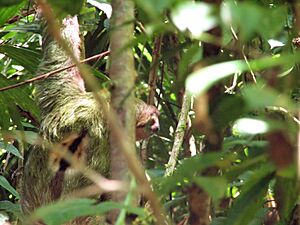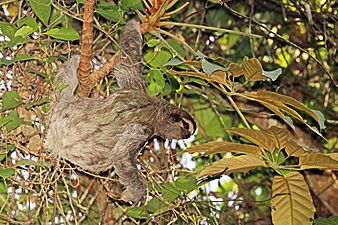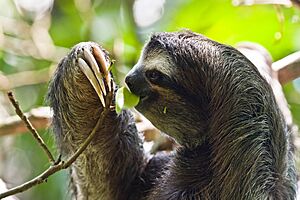Brown-throated sloth facts for kids
Quick facts for kids Brown-throated sloth |
|
|---|---|
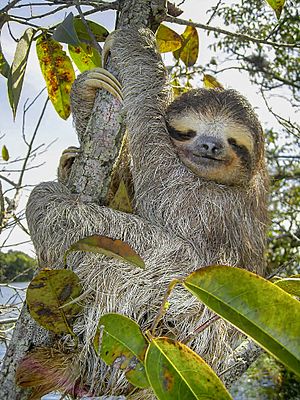 |
|
| Conservation status | |
| Scientific classification | |
| Genus: |
Bradypus
|
| Species: |
variegatus
|
| Subspecies | |
|
7, see text |
|
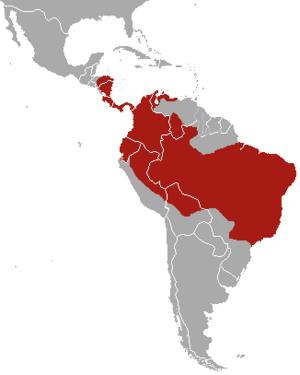 |
|
| Brown-throated sloth range | |
The brown-throated sloth (Bradypus variegatus) is a type of three-toed sloth. You can find it in the forests of Central America and South America. It's the most common of all three-toed sloths.
Contents
What Does a Sloth Look Like?
The brown-throated sloth is similar in size to other three-toed sloths. Both males and females are about 42 to 80 centimeters (16 to 31 inches) long. Their tails are quite short, only 2.5 to 9 centimeters (1 to 3.5 inches) long. Adult sloths weigh between 2.25 and 6.3 kilograms (5 to 14 pounds). There isn't much difference in size between male and female sloths.
Each foot has three long, curved claws. The front claws are about 7 to 8 centimeters (2.7 to 3.1 inches) long. The back claws are a bit shorter, around 5 to 5.5 centimeters (2 to 2.2 inches).
Their heads are round with a blunt nose and small ears. Like other sloths, they don't have front teeth (incisors or canines). Their cheek teeth are simple and peg-like. Interestingly, they don't have a gall bladder or an appendix.
Sloth Fur and Its Green Friends
Brown-throated sloths have grayish-brown to beige fur on their bodies. Their throats, sides of their faces, and foreheads are a darker brown. Their faces are usually lighter, with a dark stripe under their eyes.
Their outer fur is very coarse and stiff. Underneath, they have a softer, dense layer of fur. Sloth hairs are special because they have tiny cracks on their surface. These cracks are home to tiny algae (like tiny plants). These algae make the sloth's fur look greenish, helping them blend into the trees! Young sloths usually don't have these algae yet.
Sloth fur also has many types of fungi growing on it. Scientists have found that some of these fungi can fight against parasites, cancer, and bacteria. This is pretty cool!
Sometimes, the brown-throated sloth lives in the same areas as Hoffmann's two-toed sloth. When this happens, the three-toed sloth is usually smaller and there are more of them. They also tend to move around more during the day.
Where Do Sloths Live?
The brown-throated sloth is the most common three-toed sloth. You can find it from Honduras in the north, all the way through Nicaragua, Costa Rica, and Panama. They also live in Venezuela, Colombia, Ecuador, Bolivia, Brazil, and eastern Peru.
They live in many different types of environments. This includes wet evergreen forests and dry forests. They can also live in areas where nature has been changed by humans. Sloths usually live from sea level up to about 1,200 meters (3,900 feet) high. Some have even been seen at much higher elevations!
Sloth Life: Habits and Food
Brown-throated sloths sleep a lot, about 15 to 18 hours every day! They are only active for short times, either during the day or night. Even though they can walk on the ground and even swim, they spend most of their lives high up in tree branches. They only come down about once every eight days to go to the bathroom on the ground.
Their large, curved claws and strong muscles help them hold onto branches very tightly. They can hang upside down for a long time. This is because their organs, like their liver and stomach, are attached to their lower ribs. This keeps their organs from pressing on their lungs when they are upside down, making it easier to breathe. Adult sloths live alone, except when a mother is raising her baby. Male sloths have been seen fighting each other with their front claws.
Sloths live in the top parts of the forest, called the canopy. They eat young leaves from many different trees, especially Cecropia trees. They also eat flowers and fruits. They don't travel very far. Their home areas are usually small, about 0.5 to 9 hectares (1.2 to 22 acres). In a typical 5-hectare area, a sloth might visit about 40 trees. They might even spend up to 20% of their time in just one special tree! So, while they can eat many types of leaves, individual sloths might prefer a few specific kinds. Sloths get most of their water from the leaves they eat, but they have also been seen drinking directly from rivers.

Sloths come down from trees about once a week to go to the bathroom on the ground. Scientists have wondered why they do this. Some ideas are that it helps fertilize trees, hides their waste from predators, or helps them communicate. Another idea is that it helps a special type of moth that lives in their fur. These moths lay their eggs in the sloth's poop! However, a newer idea suggests that this behavior is just something sloths have always done, and there hasn't been a strong reason for them to stop.
Besides the algae in their fur, brown-throated sloths also share their fur with a type of moth called Cryptoses choloepi. These moths live in the sloth's fur and lay their eggs in their dung.
Sloth Predators and Sounds
Jaguars and harpy eagles are some of the main animals that hunt brown-throated sloths. Sometimes, a bird called a yellow-headed caracara will pick tiny insects out of a sloth's fur. The sloth doesn't seem to mind!
During mating season, female sloths make a loud, high-pitched scream to attract males. It sounds like "ay ay," almost like a person screaming. You can tell a male sloth by a black stripe surrounded by orange fur on his back, between his shoulders.

Baby Sloths
Brown-throated sloths usually mate between January and March in the northern parts of their home range. A mother sloth is pregnant for at least seven months. When the baby is born, it already has fur and claws.
Young sloths cling to their mother's belly for five months or more. They stop drinking milk after about four to five weeks. Baby sloths start trying solid food as early as four days after birth. They often lick food particles from their mother's mouth. This helps them quickly learn which leaves are safe to eat. Young sloths usually like the same types of leaves as their mothers.
In the wild, brown-throated sloths can live for 30 to 40 years.
Sloth Family Tree
The brown-throated sloth was first described by a scientist named Heinrich Rudolf Schinz in 1825.
There are seven recognized types, or subspecies, of the brown-throated sloth:
- B. v. boliviensis
- B. v. brasiliensis
- B. v. ephippiger
- B. v. gorgon
- B. v. infuscatus
- B. v. trivittatus
- B. v. variegatus
The closest living relative to the brown-throated sloth is the pale-throated sloth. They look very similar, except for the color of the fur around their throats. These two species separated about 400,000 years ago. Their ancestors split from the maned sloth over 7 million years ago.



